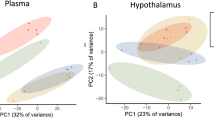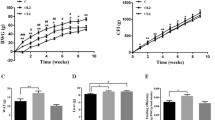Abstract
Olanzapine-induced weight gain is associated with atherosclerosis, hypertension, dyslipidemia, and diabetes. We synthesized a novel antipsychotic drug (PGW5) possessing an olanzapine moiety linked to sarcosine, a glycine transporter 1 inhibitor. In this study, we compared the metabolic effects of PGW5 and olanzapine in a female rat model of weight gain. Female rats were treated daily with oral olanzapine (4 mg/kg), PGW5 (25 mg/kg), or vehicle for 16 days. Behavioral tests were conducted on days 12–14. Biochemical analyses were performed at the end of the treatment. A significant increase in body weight was observed in the olanzapine-treated group, while the PGW5 group did not differ from the controls. The open field test showed hypo-locomotion in the olanzapine-treated animals as compared to PGW5 and control groups. A significant increase in hypothalamic protein expression of the neuropeptide Y5 receptor and a decrease in pro-opiomelanocortin messenger ribonucleic acid (mRNA) levels were detected following PGW5 treatment, but not after olanzapine administration. PGW5 appears to possess minor metabolic effects compared with the parent compound olanzapine. The differential modulation of brain peptides associated with appetite regulation is possibly involved in the attenuation of metabolic effects by PGW5.




Similar content being viewed by others
References
Albaugh VL, Henry CR, Bello NT, et al. (2006) Hormonal and metabolic effects of olanzapine and clozapine related to body weight in rodents. Obesity (Silver Spring) 14:36–51
Allison DB, Mentore JL, Heo M, Chandler LP, Cappelleri JC (1999) Antipsychotic-induced weight gain: a comprehensive research synthesis. Am J Psychiatry 156:1686–1696
Breden EL, Liu MT, Dean SR (2009) Metabolic and cardiac side effects of second-generation antipsychotics: what every clinician should know. J Pharm Prac 22:478–488
Buhmann H, le Roux CW, Bueter M (2014) The gut-brain axis in obesity. Best Pract Res Clin Gastroenterol 28:559–571
Bymaster FP, Calligaro DO, Falcone JF, et al. (1996) Radioreceptor binding profile of the atypical antipsychotic olanzapine. Neuropsychopharmacology 14:87–96
Bymaster FP, Nelson DL, DeLapp NW, et al. (1999) Antagonism by olanzapine of dopamine D1, serotonin2, muscarinic, histamine H1 and alpha 1-adrenergic receptors in vitro. Schizophr Res 37:107–122
Coll AP, Farooqi IS, O’Rahilly S (2007) The hormonal control of food intake. Cell 129:251–256
Correll CU, Lencz T, Malhotra AK (2011) Antipsychotic drugs and obesity. Trends Mol Med 17:97–107
Deng C, Weston-Green K, Huang XF (2010) The role of histaminergic H1 and H3 receptors in food intake: a mechanism for atypical antipsychotic-induced weight gain. Prog Neuro-Psychopharmacol Biol Psychiatry 34:1–4
Dietrich MO, Horvath TL (2009) Feeding signals and brain circuitry. Eur J Neurosci. 30:1688–1696
Doslikova B, Garfield AS, Shaw J, et al. (2013) 5-HT2C receptor agonist anorectic efficacy potentiated by 5-HT1B receptor agonist coapplication: an effect mediated via increased proportion of pro-opiomelanocortin neurons activated. J Neurosci. 33:9800–9804
Freedman R (2005) The choice of antipsychotic drugs for schizophrenia. N Engl J Med 353:1286–1288
Gameiro A, Reimann F, Habib AM, et al. (2005) The neurotransmitters glycine and GABA stimulate glucagon-like peptide-1 release from the GLUTag cell line. J Physiol 569:761–772
Gardner DM, Baldessarini RJ, Waraich P (2005) Modern antipsychotic drugs: a critical overview. Synthese 172:1703–1711
Gerald C, Walker MW, Criscione L, et al. (1996) A receptor subtype involved in neuropeptide-Y-induced food intake. Nature 382:168–171
Ghahramanian Golzar M, Babri S, Ataie Z, Ebrahimi H, Mirzaie F, Mohaddes G (2013) NPY receptors blockade prevents anticonvulsant action of ghrelin in the hippocampus of rat. Dv Pharm Bull 3:265–271
Gil-Ad I, Portnoy M, Tarasenko I, et al. (2014) A novel analog of olanzapine linked to sarcosinyl moiety (PGW5) demonstrates high efficacy and good safety profile in mouse models of schizophrenia. Eur Neuropsychopharmacol 24:425–436
Gupta S, Droney T, Al-Samarrai S, Keller P, Frank B (1999) Olanzapine: weight gain and therapeutic efficacy. J of Clin Psychopharm. 19:273–276
Holt RI (2006) Severe mental illness, antipsychotic drugs and the metabolic syndrome. British J Diabetes Vascular Disease 6:199–204
Hu Y, Bloomquist BT, Cornfield LJ, et al. (1996) Identification of a novel hypothalamic neuropeptide Y receptor associated with feeding behavior. J Biol Chem. 271:26315–26319
Huszar D, Lynch CA, Fairchild-Huntress V, et al. (1997) Targeted disruption of the melanocortin-4 receptor results in obesity in mice. Cell 88:131–141
Jones B, Basson BR, Walker DJ, Crawford MK, Kinon BJ (2001) Weight change and atypical antipsychotic treatment in patients with schizophrenia. J Clin Psychiatry 62:41–44
Kapur S, Remington G (2001) Atypical antipsychotics: new directions and new challenges in the treatment of schizophrenia. Ann Rev Med. 52:503–517
Katz A, Meiri N (2006) Brain-derived neurotrophic factor is critically involved in thermal-experience-dependent developmental plasticity. J Neurosci. 26:3899–3907
Larhammar D, Wraith A, Berglund MM, Holmberg SK, Lundell I (2001) Origins of the many NPY-family receptors in mammals. Peptides 22:295–307
Leslie DL, Rosenheck RA (2002) From conventional to atypical antipsychotics and back: dynamic processes in the diffusion of new medications. Am J Psychiatry 159:1534–1540
Lian J, Huang XF, Pai N, Deng C (2014) Preventing olanzapine-induced weight gain using betahistine: a study in a rat model with chronic olanzapine treatment. PLoS ONE 9:e104160
Meng H, Qingsheng Z, Chao D, Hongqin W, Jiamei L, Xu-Feng H (2014) Hypothalamic histamine H1 receptor-AMPK signaling time-dependently mediates olanzapine-induced hyperphagia and weight gain in female rats. Psychoneuroendocrinology 42:153–164
Mietlicki-Baase EG, Ortinski PI, Reiner DJ, et al. (2014) Glucagon-like peptide-1 receptor activation in the nucleus accumbens core suppresses feeding by increasing glutamatergic AMPA/kainate signaling. J Neurosci. 34:6985–6992
Moller HJ (2000) State of the art of drug treatment of schizophrenia and the future position of the novel/atypical antipsychotics. World J Biol Psychiatry 1:204–214
Mountjoy KG, Robbins LS, Mortrud MT, Cone RD (1992) The cloning of a family of genes that encode the melanocortin receptors. Science 257:1248–1251
Murashita M, Kusumi I, Inoue T, et al. (2005) Olanzapine increases plasma ghrelin level in patients with schizophrenia. Psychoneuroendocrinology 30:106–110
Nasrallah HA (2008) Atypical antipsychotic-induced metabolic side effects: insights from receptor-binding profiles. Mol Psychiatry 13:27–35
Newcomer JW (2007) Antipsychotic medications: metabolic and cardiovascular risk. J Clin Psychiatry. 68:8–13
Ottoni EB (2000) EthoLog 2.2: a tool for the transcription and timing of behavior observation sessions. Behavioral Research Methods Instruments and Computers 32:446–449
Pérez-Fernández J, Megías M, Pombal MA (2014) Cloning, phylogeny, and regional expression of a Y5 receptor mRNA in the brain of the sea lamprey. J Comp Neurol 522:1132–1154
Pouzet B, Mow T, Kreilgaard M, Velschow S (2003) Chronic treatment with antipsychotics in rats as a model for antipsychotic-induced weight gain in human. Pharmacol Biochem Behav. 75:133–140
Poyurovsky M, Fuchs C, Pashinian A, Levi A, Weizman R, Weizman A (2013) Reducing antipsychotic-induced weight gain in schizophrenia: a double-blind placebo-controlled study of reboxetine-betahistine combination. Psychopharmacology 226:615–622
Qingsheng Z, Meng H, Chao D, Hongqin W, Jiamei L, Xu-Feng H (2014) Hypothalamic ghrelin signalling mediates olanzapine-induced hyperphagia and weight gain in female rats. Inte Jl of Neuropsychopharm 17:807–818
Rolls ET (2005) Taste, olfactory, and food texture processing in the brain, and the control of food intake. Physiol Behav 85:45–56
Sadock B, Sadock V (2007) Synopsis of Psychiatry, 1st edn. Lippincott, Philadelphia, Pa, USA
Schwartz MW, Woods SC, Porte Jr D, Seeley RJ, Baskin DG (2000) Central nervous system control of food intake. Nature 404:661–671
Stefanidis A, Verty ANA, Allen AM, Owens NC, Cowley MA, Oldfield BJ (2009) The role of thermogenesis in antipsychotic drug-induced weight gain. Obesity 17:16–24
Umbricht DS, Pollack S, Kane JM (1994) Clozapine and weight gain. J Cli Psychiatry. 55:157–160
Van der Zwaal EM, Janhunen SK, la Fleur SE, Adan RA (2014) Modelling olanzapine-induced weight gain in rats. Int J Neuropsychopharmacol 17:169–186
Zugno AI, Barcelos M, Ld O, et al. (2012) Energy metabolism, leptin, and biochemical parameters are altered in rats subjected to the chronic administration of olanzapine. Rev Bras Psiquiatr 34:168–175
Acknowledgments
This study was supported by a grant from the National Institute for Psychobiology in Israel.
Author information
Authors and Affiliations
Corresponding author
Rights and permissions
About this article
Cite this article
Taler, M., Vered, I., Globus, R. et al. Attenuated Weight Gain with the Novel Analog of Olanzapine Linked to Sarcosinyl Moiety (PGW5) Compared to Olanzapine. J Mol Neurosci 58, 66–73 (2016). https://doi.org/10.1007/s12031-015-0679-2
Received:
Accepted:
Published:
Issue Date:
DOI: https://doi.org/10.1007/s12031-015-0679-2




